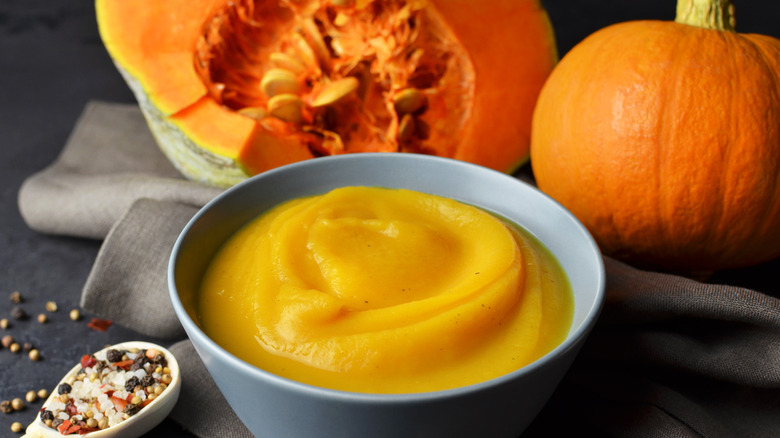The '100% Pumpkin' Label On Canned Puree Isn't Exactly True
When it comes to ingredient lists on commercial products, it doesn't get simpler than canned pumpkin purée. Big cans proudly labeled "100% pure pumpkin" very rarely list anything more than "pumpkin" as an ingredient on the fine print, claiming to have no additives, substitutes, or artificial flavoring. You might pick up a can of the vividly orange paste thinking that you're guaranteed nothing but a mash of the big, bright, season-defining pumpkin as you know it — but sadly, you'd be wrong.
The truth is, while commercial products have to abide by FDA regulations on labeling transparency, the FDA's standard of what can or can't be labeled as "pumpkin" is looser than you might think. The exact definition is outlined in Compliance Policy Guide Sec 585.725: The label of "pumpkin" can be applied to any "articles prepared from golden-fleshed, sweet squash or mixtures of such squash and field pumpkin."
Given that "golden-fleshed" and "sweet" applies to an incredibly large variety of squash, the FDA-approved ingredient list on a can of pumpkin purée doesn't tell you much about what's really inside. A can could actually contain no traces of the traditional carving pumpkin as you know it and still be legally labeled "100% pumpkin purée." This actually is the case with household name brands like Libby's and Ed Smith, both of which use an heirloom squash variety called the Dickinson pumpkin instead of the common field pumpkin.
A gourd by any other name
Of course, the Libby's official website disagrees vehemently. The company claims that "Libby's proudly uses nothing but 100% pumpkin," on the scientific technicality that all pumpkins are varieties of squash under the cucurbitaceae family of plants. While this might seem like a very simplified, brute-force approach to the matter, it highlights an incredibly important factor in whether or not "100% pumpkin" labels are wholly truthful or not. The simple truth is, any and all attempts to clearly and comprehensively distinguish between pumpkins and squashes will lead absolutely nowhere.
Botanically speaking, the distinction is almost entirely arbitrary and linguistic; there is no biological trait that clearly sets pumpkins apart from squashes. Even cucurbita pepo, the plant species that carving pumpkins belong to, is actually better known for producing many varieties of summer and winter squashes. With that in mind, who's to say that the Dickinson pumpkin or other sweet squashes used in canned purée truly aren't pumpkins, or that "100% pumpkin" labels are untruthful?
Botanical taxonomy and labeling regulations aside, it's probably a good thing that most canned pumpkin brands use squashes instead. The only thing the common field pumpkin brings to the table when it comes to purée is authenticity to the autumn aesthetic and nothing else. It's stringy, watery, and ill-suited for making pumpkin pie filling compared to the buttery smooth paste you'd find in a can — you're better off sticking to your usual can of purée.

